|
Electrostatics
Electromagnetics
Electricity &
Magnetism
© The scientific sentence. 2010
|
Electromagnetics: Motion of charges
in electromagnetic fields
1. Circular path of charged particle
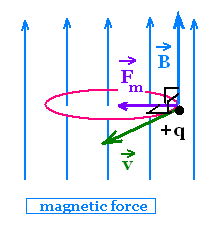
Consider a positive charge +q that starts to move
at constant velocity v in a uniform magnetic field B
directed upward. The related magnetic force Fm
is perpendicular to the plane formed by v and B.
This force is the only force that is
acting on the particle. While this
force acts on this particle, the trajectory of the
particle must change to maintain F, B and V
perpendicular to each other. Therefore the particle
becomes forced to moves on a circle.
From Newton's second law, the magnetic force is then
a centripetal force (radial force) of magnitude
Fc = m v2/R.
m is the mass of the charged particle, and R is the
radius of its circular trajectory.
This force is equal to the magnetic force Fm.
Equating gives:
m v2/R = q v B
Solving for R gives:
R = m v/q B
Radius R of the circular path of a charged
particle q of mass m, moving at constant speed v,
in a uniform magnetic field B:
R = mv/qB
The angular speed or angular frequency is
ω = v/R = (q/m)B
It depends only on the field B and the charge-to-mass ratio q/m
of a given particle.
The operation of a cyclotron is based on this
property. This is why the frequency ω is called
cyclotron frequency.
2. Lorentz force
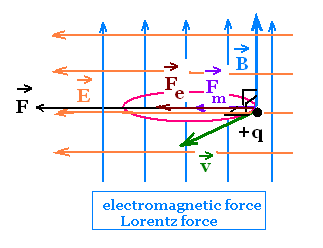
In the case of the charged particle q moves
in both electric E and magnetic field B, that is
an electromagnetic field, the combined force
F that acts on the particle becomes the electromagnetic
force that is the vectorial some
of Fe and Fm:
F = Fe + Fm = q E + q v x B
That is called Lorentz force.
| → |
|
→ → |
→ |
| F = q |
|
(E + v x |
B) |
| |
|
|
|
3. Applications
3.1. The cyclotron
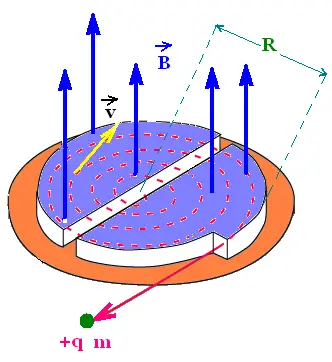
A cyclotron accelerates charges particles. It consists of
two D-shaped regions known as dees in a magnetic field,
separated by a gap under uniform electric field due to an alternating
potential difference.
A charged particle leaves a dee, accelerated across the gap before to
reach the other dee. Once accelerated, the particle gain speed, then
radius. Under the magnetic field, the path of the particle becomes curved.
The particle returns to the gap at another position and encounters
the alternating potential difference across the gap that accelerates
it again. The process is repeated until the particle leaves the
cyclotron.
The applied accelerating potential difference is maintained
in phase with the circulating charge particle, by an oscillator
at the same angular frequency ω as the charged particle.
The angular frequency of the charged particle, that is the
cyclotron frequency of the particle, must match all
the time the angular frequency of the oscillator.
A positive charge q of mass m is being accelerated in a cyclotron
with a uniform magnetic field B. Its angular frequency ω depends
only on the ration (q/m) and B: ω = (q/m)B, hence it remains the same.
The velocity of the charged particle at the last turn, when the
radius is R, that is at the outer edge of the dee is v = ω R.
The particle leaves the cyclotron with a kinetic energy KE =
(1/2)m v2 = (1/2)m (ω R)2 =
(1/2)m (q/m)2B2 R2 =
q2B2 R2/2m.
KE = (qBR)2/2m
The maximum of this kinetic energy is limited when the speed of
the particle approaches that of light. The relativistic effects
make the frequency ω depends on the speed. In a
synchrocyclotron, to overcome this effect, we change the
frequency of the oscillator to synchronize, at each cycle, the two
frequencies.
For example, an accelerated proton +e emerging from a cyclotron
of radius R = 50.00 cm with a magnetic field of magnitude
B = 1.5 T has:
• The cyclotron frequency ω = (e/m)B
= (1.6 x 10-19C/1.67 x 10-27)1.5 =
1.5 x 108 rad/s
• The speed v = ω R
= 1.5 x 108 (rad/s) . 0.5 (m) =
4.5 x 107 m/s
• The kinetic energy
KE = (1/2) m v2
= (1/2) (1.67 x 10-27)(4.5 x 107)2 J
= 16.90 x 10-13 J =
16.90 x 10-13 eV / 1.6 x 10-19
= 10.57 x 106 eV =
11 MeV.
3.2. The Hall effect
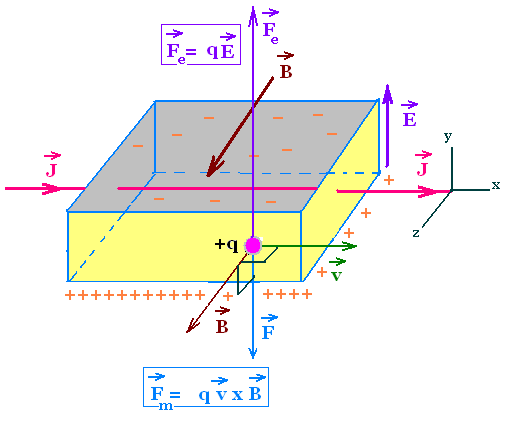
Consoder a current carrying conducter in a form of a strip
crossed by an electric current of current density J in
a uniform magnetic field B.
Whith a given sense of current (J in x-direction), negative charge (-q) moves
in the opposite direction and positive charge in the same direction.
In both cases the magnetic force Fm is directed
downward. The charges are then accumulated on the lower and upper
surfaces.
This charge separation produces an electric field E in the
conductor exerting an electric force Fe on the moving
charge. The accumulation of the charges continues until the
electric force Fe balances the magnetic force Fm
in which we reach the steady state. The corresponding electric field
is called Hall-field.
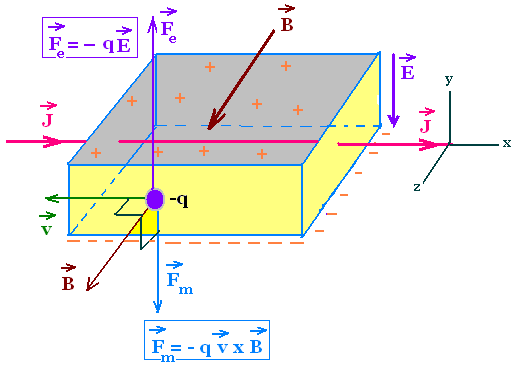
The magnitude of the current density is J = n q v
n is the number of carriers per unit volume (or
density of carriers)
q is the charge of each carrier
v is the magnitude of the drift velocity
At the steady state, we have:
q v B = q E , that is
E = v B = JB/nq or
B = E/v = (nq/J)E
Having a device calibrated with a given E
and J, the hall effect can be used to determine B
in a region by measuring the Hall field.
|
|